Trashion Fashion Show | Project Refuge

A "trashion" show is where designers create fashion from trash. Making clothing from up-cycled throw away items, is a fun, creative exercise in design. It also promotes awareness of sustainability and waste reduction, so it's the perfect theme for a fundraising vehicle. 'Project Refuge: A Couture Fashion Show Using Trash' was the celebration of the 75th anniversary of the J.N. "Ding" Darling National Wildlife Refuge in Sanibel Island, Florida. A lighthearted fundraiser that also educated the public on the more serious issue of how trash impacts the environment of the refuge. “Ding” Darling Wildlife Society-Friends of the Refuge (DDWS) Executive Director Birgie Miller tells us more in this interview.
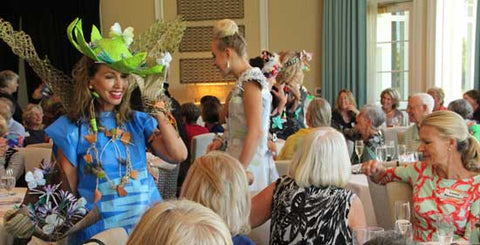
Project Refuge Fundraiser, all images, Scott McPhee/DDWS
Escama: How did you come up with the idea for an upcycled fashion show & luncheon as your fundraiser? Do you have fashion designers on the committee?
Birgie: No designers on the committee, just creative people with a passion for educating the public on the excess of trash and what it does to our environment and to our lives in general. The mission of the Refuge and Society is to educate and inspire, and the committee had seen other communities around the country do similar shows and we decided to do one ourselves.

Winning designs from the Couture Fashion Show Using Trash
Escama: The word 'Trashion' is conspicuously missing from the show brochure.
Birgie: One of our goals for the event was to make it a little "classier" by calling it a 'Couture Fashion Show Using Trash', because beautiful garments can be made with trash.
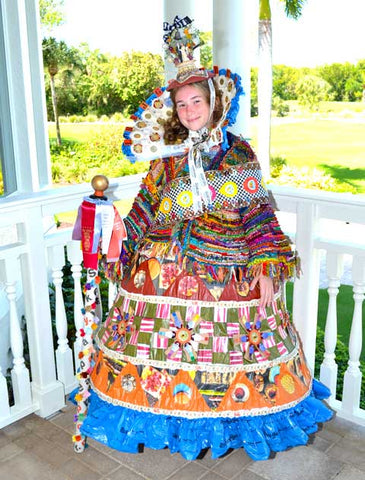
1st Place Winner, Downton Shabby, Design Team: Penny Weinstein, Lois Dwartz, Model: Hayden Lambek
Escama: There were a total of 23 fantastic 'Trash Couture' dresses all made of recycled materials. Were the participants fashion designers?
Birgie: Of the twenty three designers in the show only three were what they would call themselves professional artists or designers. All the other designers (and teams) were local residents with the enthusiasm to create something unique using trash. Many of them perused the Internet and youtube videos to get ideas and then ran with their own ideas for what resulted in spectacular designs.
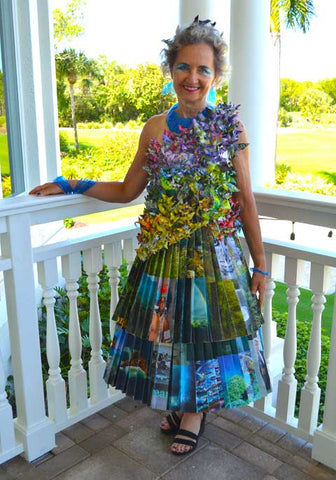
2nd Place Winner, Cover Story, Design Team: Linda Lange, Mary Jane Christie, Richard Franco, Model: Linda Lange
Escama: Is there a big following for trashion fashion in your area? How was the event received?
Birgie: Not sure how widespread the whole trashion fashion trend is, but this event proved to be very popular with both the designers and the attendees. It was fun, quirky and educational, while raising important philanthropic support for the charity.
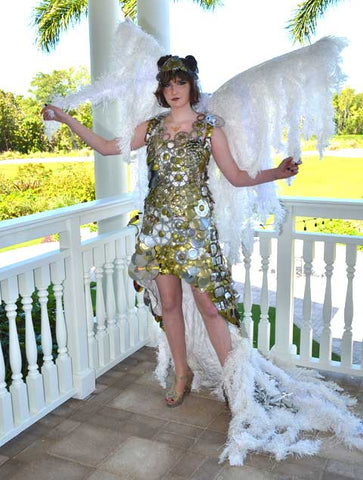
3rd Place Winner, Steel Mary, Design Team: Sara Basehart, Jenna Basehart, Model: Jenna Basehart
Escama: Was the Couture Fashion Show Using Trash a successful fundraising event?
Birgie: Hosting this as a first-time event, we weren't sure what to expect. A lot of work went into it behind the scenes, but the entire event was a great success. We raised nearly $20,000 for the conservation work the J.N. "Ding" Darling National Wildlife Refuge and introduced a new group of people who attended this event to the Refuge. And we educated all of them about trash in our environment with hopes they will try to live their lives a little more responsibly.
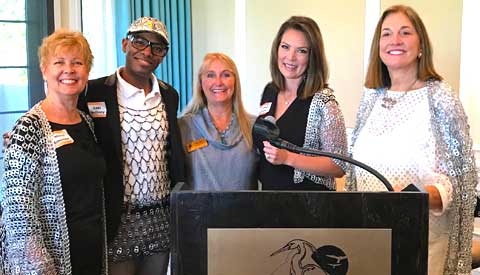
Project Refuge judges wearing Escama upcycled apparel
Escama: So, you're saying that there may be more couture trash shows on the horizon?
Birgie: We plan to have another Project Refuge: A Couture Fashion Show using Trash in 2022 to be held at a much larger venue to allow for increased attendance.
Scroll Down to See All 23 Designs, Designer Statements & Video !
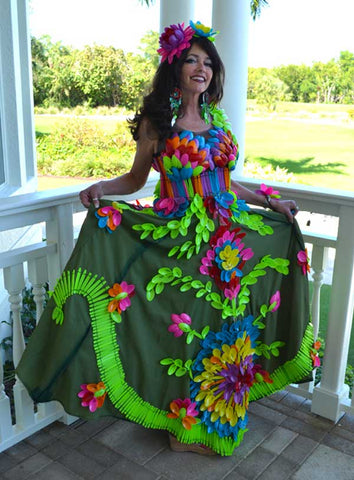
Spoonful of Lovin', Design Team: Sarah Basehart, Jenna Basehart, Model: Sarah Basehart. (for more about Sara click here)
This dress is called Spoonful of Lovin' and it is made from hundreds of plastic spoons collected from the trash at our local frozen yogurt place, Ziggy's. They had such beautifully colored spoons and to watch them hit the trash was maddening. They agreed to let me collect them for an art project and I put a bin out decorated and proudly labeled "SPOONS for RECYCLING for ART" and started getting a full can every 2-3 days. Inspired by Scandanavian flower fabric prints, I began cutting, drilling, and hand sewing the spoons onto a dress made from the canopy of a broken market umbrella from the dumpster next to a restaurant. So, I am doing my best to make something truly lovely from this plastic waste. The only non-recycled material used is the thread.
The Darling Drapery Dress, Design Team: Cristy Kikkert, Patty Arenburg, Model: Cristy Kikkert
The Darling Drapery Dress is a full-length, fully lined gown that is close-fitting through the bust with "cut-away" arm holes. The outer layer was constructed using white polyester drapery fabric and the lining was made from different white recycled curtains, both retrieved from the Charlotte County Recycle Center. It features a mock turtleneck collar with pleat detail descending from the collar to the bust-line where the pleats and collar are embellished with aqua, silver, and white beads and buttons from discarded jewelry. The white dress represents the vision of a pure, clean southwest Florida white sand beach with aqua colored gulf water washing toward the shoreline. Unfortunately, it is a vision of what once was a reality... but also a vision of what could be again, if we as the human race are cognizant of the myriad of pollutants we emit into the environment on a daily basis.
Recycled Gifts From The Sea, Design Team: Colleen Bauer, Kerri Maw, Skyler Bauer, Mary Beth Greenplate, Chelle Walton, Khristy Scheer. Model: Skyler Bauer
For this creation, we envisioned the bride of Neptune. Many materials came from the waste bin at Sanibel Seashell shop, including the shells, which patrons bring to the owners to repurpose for crafts when they no longer want them. The fish-netting was originally used in store decoration but was to be discarded. The earrings and lures and bobbers that festoon the shirt are courtesy of the Refuge’s Monofilament Busters, who clear mangroves of monofilament and fishing gear. We’ve added wisps of the monofilament, which get wrapped up in trash the trees, and can harm and kill wildlife.
It's A Dog's Life, Design Team: Laura DeBruce, Sarah Ashton, Kassie Witte, Jan Alden. Model: Lisa Fox
Wearing a plastic Purina dog food bag decorated with dog waste bags and cinched at the waist with a dog leash. The purse is made from a smaller-sized Pedigree dog food bag using a discarded plastic dog pull toy as a handle and a dog treat as a toggle clasp. The over-the-shoulder strap is an formerly used dog collar. Our model wears an old dog bowl as a hat with a stuffed dog toy as decoration on top. The hat is tied to her head with dog waste bags. All dog waste bags used in the creation of this outfit will be put to good use after the show, but are a reminder to find eco-friendly alternatives to using plastic to pick up after your dog.
Gari's Trashin' - Fashion, Design Team: Gari Lewis, Model: Gari Lewis
Setting out in Trashin Fashion is a design inspired from garbage, trash and beach debris discarded on the shores of Sanibel’s east end. The close-fitting, flared asymmetrical dress feature detailed, multi-panels of woven, sparkle knit. The puff sleeves are constructed from nylon netting and gather at the cuff with the designer's signature “Benitha Bloom” flowers made from plastic shopping bags, 13 in all. The underneath circle shirts is a retired boat plastic shower curtain. This outfit is accessorized with a “Fascinator-like” headband. Fishing gear, line and lures complete a total look for the necklace and earring set.
World's Most Expensive Dress, Design Team: Shelley Greggs, Ruthi Levering, Model: Ruthi Levering
Here is the World’s Most Expensive Dress! While the materials come free with every online purchase you make, future populations will be paying for it for generations to come. These non-recyclable pieces won’t decompose for centuries, costing us our clean air, clean water and natural resources. Amazon mailers form the basis of the dress and pashmina. Protective foam packing inserts make the hat, bracelet, and ring and are adorned with plastic Mardi Gras beads from NOLA. Also used are plastic phone wires for the necklace, plastic flipflops, cigar cases for earrings and vegetable packaging with broken costume jewelry for the purse. Chains and beads from Mardi Gras also bejewel these pieces.
Hanu, Design Team: Sedona Lehua, Trinity Joy Model: Kaia Marianne
This dress is made out of plastic water bottles, bags, caps, cereal boxes and gum wrappers. All of these materials were collected out in the Lee County community and local school. Plastics are detrimental to the ocean as they release harmful chemicals that cause health issues for wildlife. Wildlife often consumes or gets trapped in these plastics. To demonstrate this issue, as embellishments the turtle decorations were created out of plastic water bottles. Here in SWFL we are surrounded by beautiful beaches and canals. With this dress we hope to promote keeping our waters clean for future generations to enjoy.
Sac's de Courses, Design Team: Kathleen Straubing, Aleeya Khan, Model: Aleeya Khan
This fashion is a reminder to always ask for paper bags if you forget to bring your reusable bags to the grocery store. Keep in mind that you have to reuse a paper bag four times to reduce its carbon footprint to that of a single-use plastic bag. We can all do our part by reusing grocery bags or recycling them into a wearable fashion, gift wrap, book covers, note pads, arts & crafts, a collector for compost, and so much more.
Come Rain, Come Shine, Design Team: Carol Strange, Mary Beth Greenplate, Models: Sophia Westland, Madeline Davie
I was raised to be a conservationist. It was a way of life. Dad was the trash guy and he burned a lot, composted the victory garden, and we were always saving bacon drippings, newspapers and washing our hands. Lots of family were in close proximity so clothing was swapped between cousins. As an adult, I continue keeping odd things which this design is a reminder of the waste produced in annual credit cards, sales gimmicks and memberships. Many of them were pretty and interesting, so I kept them through the years. The throwaway rain poncho came from my granddaughter's graduation in Boston, while the decorated umbrella had become something of a family heirloom fit for Philly Mummers. Jean Chandler tells us to turn a vicious cycle into a virtuous one; accept the challenge and make it a habit to Reuse, Recycle, and Reduce!
Spinning in My Kimono, Design Team: Patty Arenburg, Cristy Kikkert, Model: Patty Arenburg
Sailing into our hearts, this dress speaks to the many aspects of sailboats that can be recycled and re-purposed. The kimono is made directly from recycled sailboat spinnaker, while metal stampings from a diesel motor cooling system were also re-purposed into this design. Other materials such as a curtain used to make the sleeves and front trim on the design were gathered at the Charlotte County Recycle Facility in Port Charlotte. Accented with floral touches, this kimono will leave you spinning in your seat!
Colorful Morning Newes, Design Team: Sherri Newes, Model: Sherri Newes
This design is made to head to the beach. The crocheted beach cover-up is made with strips of the plastic bags collected from the bags the News Press delivers each morning. She's carrying her beach bag made from those same strips. She has her beach mat made from the same process, only using the heavier bags from local shopping and grocery stores. It works great in keeping her comfy on the sand and keeping the sand out. While the bags are actually made from recycled materials, they cannot be recycled themselves, so hundreds of plastics were saved in all of these items. Asked how many bags she used to make the cover-up, Sherri said she lost count after 500 and probably doesn't really want to know.
Catalog to Computers, Design Team: Carol Rosenberg, Pegret Harrison, Pamela Browning, Bert Andresen, Model: Jenny Rosenberg
The wrap dress is made from flame-proofed Chicos Catalog pages sewn onto used, stained vintage tablecloth lining. The hat is Chicos Catalog paper roses with tags and netting from Florida oranges bags. Resale-shop black shoes were painted to coordinate with the dress and purse embellishment. The Jewelry Team removed parts from old, retired, outdated, broken computers, TVs, printers and keyboards. This includes logic boards, video cards, RAM boards, hard drives and induction coils. Preparation required filing, sanding, drilling with intent to preserve integrity, appearance and ensure safety and comfort for the model. Focus was to maintain a sense of design, uniqueness and elegance which then evolved into a new goal of funky-junkie smile-makers.
A Reel Corker, Design Team: Barb Rogers, Model: Barb Rogers
Interestingly, the vast majority of oceanic garbage is not plastic straws and bags, it's fishing gear. Fishing nets alone make up 46 percent of this garbage. The slip is made from surgical drape material obtained from leftover pieces used at the Clinic for the Rehabilitation of Wildlife (CROW). Hospitals create nearly six million tons of garbage a year. The Operation Rooms in hospitals contributes roughly 20 - 30% of a hospital's waste. Recycling drape material can significantly reduce this waste. The corks are contributed from a wide variety of sources on the island. Cork is a 100% natural, biodegradable and renewable resource. The corks in this outfit represent the best option for reducing waste in our environment, and are painted to represent the ocean and the red coral that is being decimated in so many areas. The dress is hand sewn using leftover thread and strips of plastic bags.
Lunchroom Leftovers, Design Team: Kathy Daddato, Audrina Westland, Sophia Westland, Model: Audrina Westland
This entry is to reflect what today’s youth is eating in our school cafeterias and the waste produced from the leftovers. The dress bodice (top) is created from 36 woven Capri Sun drink pouches, while the skirt is made up of 142 pouches in total, varying from items such as Doritos to fruit snacks. The back is made out of milk cartons, both of which are not recycled in the local school lunch rooms. All of the reusable materials used in this design are NOT recycled in our area schools. This model collected trash from classmates at Tanglewood Elementary during lunch before proceeding to clean and dry the trash for her designer grandmother to create the work of art.
Steam Punk, Design Team: Nancy Wickham, Nicole McHale, Mary Ruedisueli, Model: Clare Harris
Our Steampunk inspired rubber inner tube, bicycle tire frock is complete with a hoop skirt fashioned from re-purposed old bicycle wheels. Embellishments on the garment, gloves and fascinator are antique furniture hardware pieces. Discarded window screen was used for the fascinator and to create the straps on the dress.
Mixed Bag, Design Team: Ann Potter, Linda Potter, Nancy Rust, Model: Maryanne Daly
Our creation is a mixed bag because it was designed and crafted by multiple friends/family and using various types of plastic bags and materials in its design. It was created with many colorful newspaper bags, chip bags, aluminum can pop tops and plastic rings from water bottles. Plastic bags can take anywhere from 10 to 10,000 years to decompose in a landfill dependent on their chemical makeup. Plastic from water bottles will remain in our environment for approximately 450 or more years. Aluminum cans take 80 to 200 years to decompose in a landfill. Many of our U.S. recycling centers are overwhelmed since China will no longer accept a majority of our plastic and paper recycling. Globally that means more plastics are ending up in landfills.
Office Chic, Design Team: Constance Walker, Alexa Collins, Model: Alexa Collins
Our mailboxes are bombarded with junk mail daily. This design used many different sizes and styles of envelopes collected from junk mail. Using the patterns on the inside of the envelopes they were pieced together in a specific pattern to create the “fabric” for this design.The envelopes were then sewn together with a sewing machine. In addition to the envelopes, shredded paper was collected from the office shredder and used to construct the sleeves of the dress. The purse and jewelry in this design were made using stamps cut from the envelopes we receive in the mail. Another major issue is old computers and parts. Our office recycles them through a special electronics recycle facility in our city and keyboard keys were used to construct “special” wording on the back of the dress and for making jewelry. Paper is being wasted by the millions on a daily basis through junk mail, producing approximately 1 billion pounds of landfill each year. Junk mail must be stopped. Who enjoys or looks forward to having to deal with junk mail on a daily basis? Nobody!
Steel Mary, Design Team: Sara Basehart, Jenna Basehart, Model: Jenna Basehart
This dress is called Steel Mary- she is constructed from over 35 lbs of metal scrap; keys, bottle caps, can lids, poptops, bike gears, cogs, belt buckles and also includes non-recyclable plastic waste such as coffee bags, woven polypropylene chicken feed bags, & music cds. It has operable wings constructed out of the chicken feed bags deconstructed and resewn into feathers. Every single piece is hand sewn onto the chicken bag base by hand.
Litter Bug, Design Team: Lily Hatchett, David Hatchett, Model: Toni Ferrell Sutton
I have been collecting fabulous plastic bags since the eighties. They are high in polyvinyl and not environmentally friendly. That same quality makes them tough and beautifully colored. I have been using them in my art as sculpture material. The black material, also a vinyl, is a byproduct of my NYC nightclub upholstery work, specifically Danceteria banquettes. I saved everything to keep it from going to landfills.
Cover Story, Design Team: Linda Lange, Mary Jane Christie, Richard Franco, Model: Linda Lange
Our model today is wearing an outfit made from newspaper, magazines, duct tape, polyurethane and hot glue, it reminds us that for today and the foreseeable future, the planet’s cover story is climate change. 98 images on the 2-tiered skirt show various species and habitat our planet continues to support and the looming environmental threats we are facing. The bodice is covered with approximately 250 origami butterflies, the symbol of endurance, change, hope and life; everything we’ll need to face the environmental challenges of today. The jewelry is made from recycled beverage cups.
Bloomin' Trash, Design Team: Sherry Purdy, Sheryl Steele, Karen Ryan, Jackie Sweeney, Carol Goode, Barb Cecala, Model: Hannah Pauly
The primary focus for this design was plastic because the world is currently producing nearly 300 million tons of plastic each year - a significant amount of which will end up in the oceans. Unfortunately, although plastic is an inexpensive, versatile product, many things made from it are created for single-use - with an estimated 50 per cent of plastic used once and thrown away. The top and skirt are made from re-purposed black plastic bags and the white overskirt is made from a decades old cotton tablecloth, embellished with flowers made from re-used tissue paper and attached using monofilament fishing line. The accessories also highlight the need to reuse and recycle, from the aluminum pop tops down to the styrofoam on the nails! This project has truly highlighted the need for all of us to become more environmentally conscious, sooner than later.
The Garden Fairy, Design Team: Jaye Boswell, Lynne Stern, Katie Branam, Mimie DiRico, Model: Mary Meyer
Our family philosophy has always been "Make Do", short for "Make Do With What You Have", rather than head for the store for the newest and trendiest items. This design showcases exactly that, from the dress down to the accessories adorning this design. The dress was made using remnants from Hurricane Charlie, a FEMA blue roof tarp. A leaky garden hose was re-purposed into beautiful flowers on the dress, and plastic gallon water jug was transformed into the hat. The search for safer, cleaner, healthier and longer lasting lifestyles must be a priority for all of us.
Downton Shabby, Design Team: Penny Weinstein, Lois Dwartz, Model: Hayden Lambek
The ladies in waiting at the English manor house, Downton Shabby, flew into an uproar at the news that Lady Lillian Lewis has been invited to the States to appear in a Trashion Show. The challenge of turning rubble into bubbles hooked her on the idea, as she was known worldwide for her uncanny use of trash to create her daily attire. Today, on the runway, she is sporting a designed using a wedding cake topper, a jacket knit from skeins of yarn and sari scraps, a fabulous Elizabethan collar adorned with old lace doilies, parts of a yo-yo quilt, and antique puzzle pieces, a royal sash created from cut up tag sale shower curtains and old chair trim remnants, a royal scepter fashioned together using discarded newsprint role and more, and finally a traditional skirt made in the style of her Victorian ancestors from newspaper panels, glass bottle milk caps, surveyors tape and more. Our Lady Lillian has always lived by the words of her dearly departed friend and partner in crime, Mae West: "Too much of a good thing can be wonderful." Her entry into this year's Project Refuge certainly bears that out.


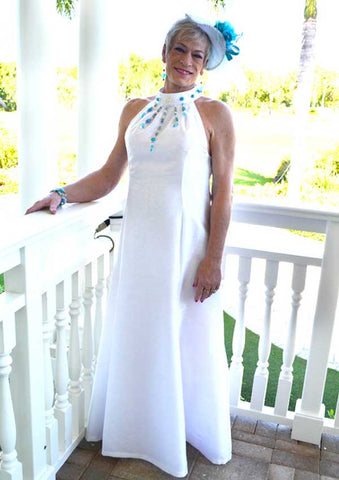
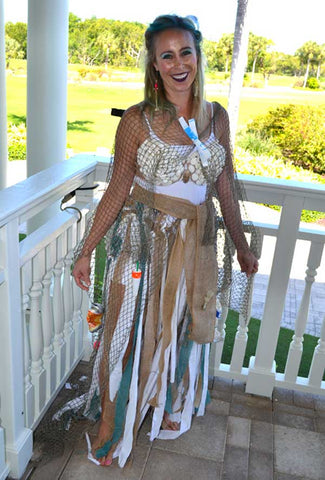
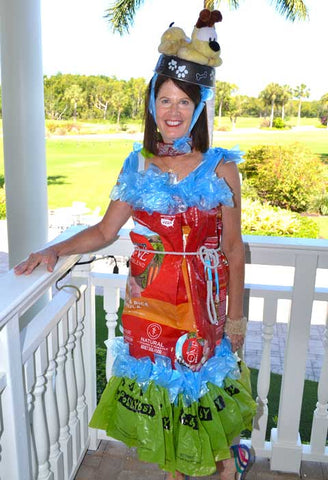
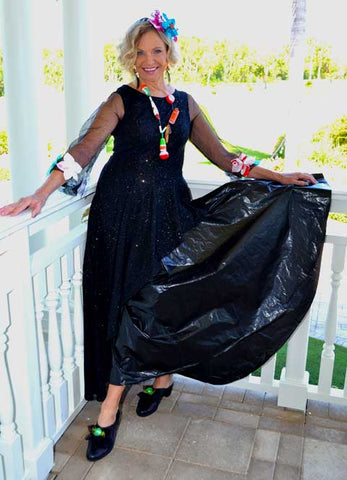 Gari's Trashin' - Fashion, Design Team: Gari Lewis, Model: Gari Lewis
Gari's Trashin' - Fashion, Design Team: Gari Lewis, Model: Gari Lewis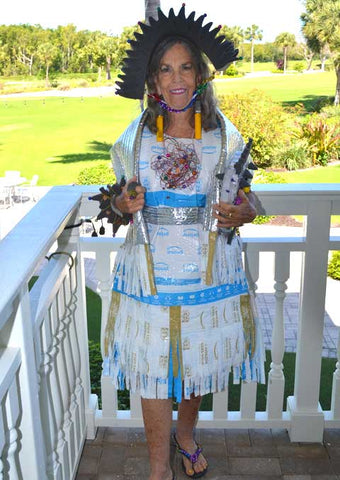

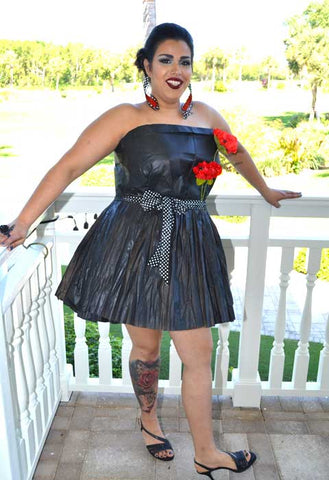
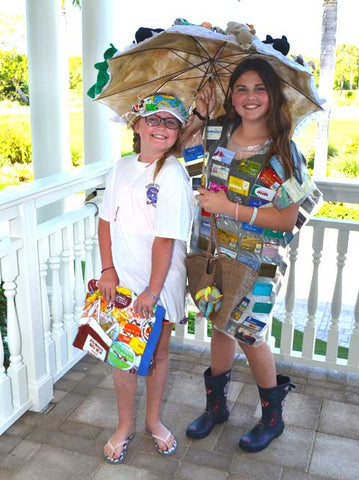
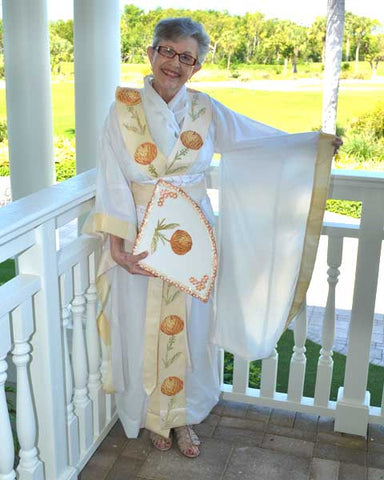 Spinning in My Kimono, Design Team: Patty Arenburg, Cristy Kikkert, Model: Patty Arenburg
Spinning in My Kimono, Design Team: Patty Arenburg, Cristy Kikkert, Model: Patty Arenburg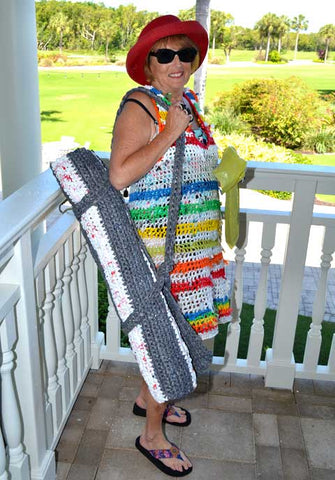 Colorful Morning Newes, Design Team: Sherri Newes, Model: Sherri Newes
Colorful Morning Newes, Design Team: Sherri Newes, Model: Sherri Newes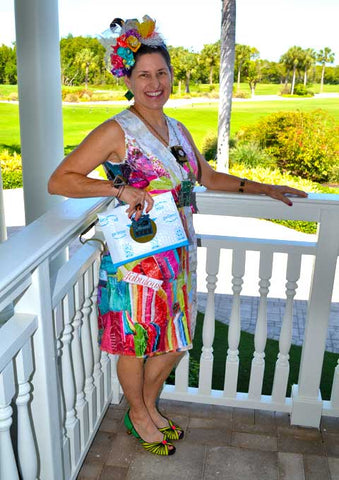 Catalog to Computers, Design Team: Carol Rosenberg, Pegret Harrison, Pamela Browning, Bert Andresen, Model: Jenny Rosenberg
Catalog to Computers, Design Team: Carol Rosenberg, Pegret Harrison, Pamela Browning, Bert Andresen, Model: Jenny Rosenberg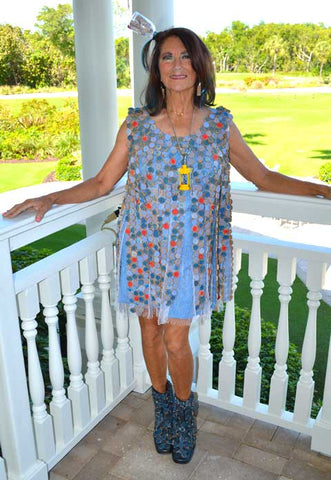 A Reel Corker, Design Team: Barb Rogers, Model: Barb Rogers
A Reel Corker, Design Team: Barb Rogers, Model: Barb Rogers
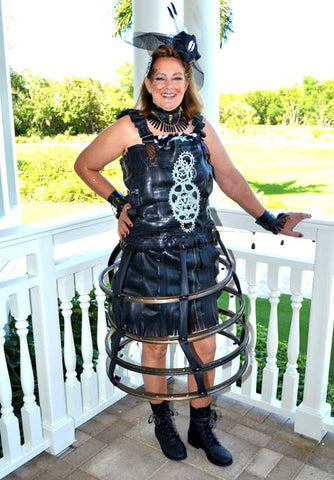
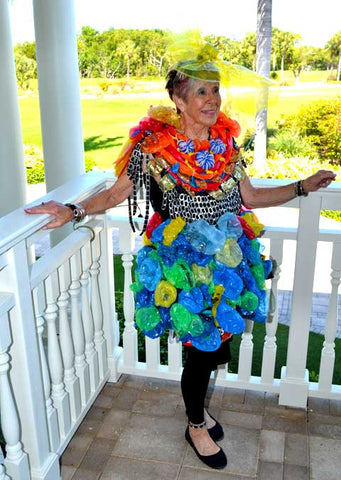 Mixed Bag, Design Team: Ann Potter, Linda Potter, Nancy Rust, Model: Maryanne Daly
Mixed Bag, Design Team: Ann Potter, Linda Potter, Nancy Rust, Model: Maryanne Daly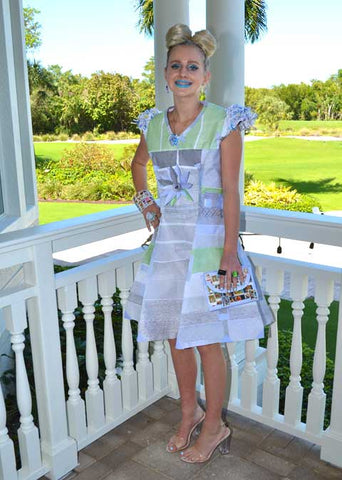 Office Chic, Design Team: Constance Walker, Alexa Collins, Model: Alexa Collins
Office Chic, Design Team: Constance Walker, Alexa Collins, Model: Alexa Collins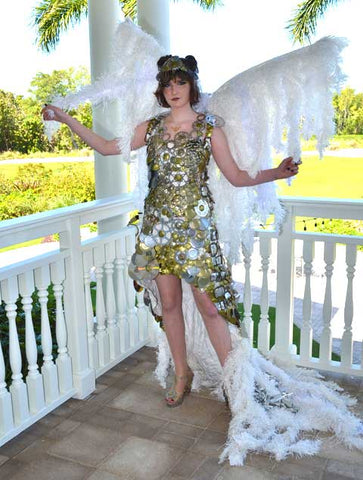 Steel Mary, Design Team: Sara Basehart, Jenna Basehart, Model: Jenna Basehart
Steel Mary, Design Team: Sara Basehart, Jenna Basehart, Model: Jenna Basehart Litter Bug, Design Team: Lily Hatchett, David Hatchett, Model: Toni Ferrell Sutton
Litter Bug, Design Team: Lily Hatchett, David Hatchett, Model: Toni Ferrell Sutton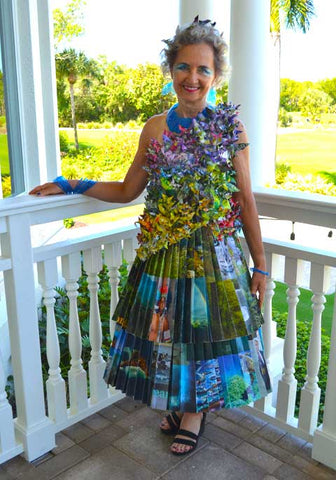 Cover Story, Design Team: Linda Lange, Mary Jane Christie, Richard Franco, Model: Linda Lange
Cover Story, Design Team: Linda Lange, Mary Jane Christie, Richard Franco, Model: Linda Lange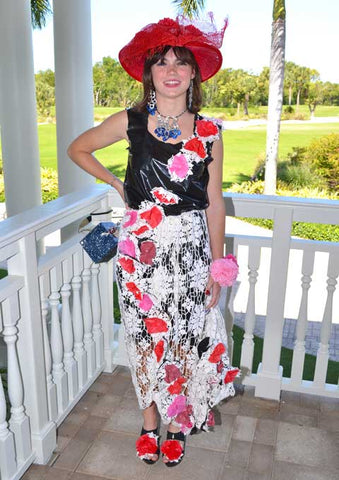 Bloomin' Trash, Design Team: Sherry Purdy, Sheryl Steele, Karen Ryan, Jackie Sweeney, Carol Goode, Barb Cecala, Model: Hannah Pauly
Bloomin' Trash, Design Team: Sherry Purdy, Sheryl Steele, Karen Ryan, Jackie Sweeney, Carol Goode, Barb Cecala, Model: Hannah Pauly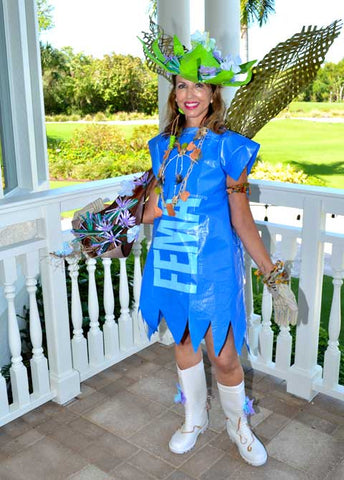 The Garden Fairy, Design Team: Jaye Boswell, Lynne Stern, Katie Branam, Mimie DiRico, Model: Mary Meyer
The Garden Fairy, Design Team: Jaye Boswell, Lynne Stern, Katie Branam, Mimie DiRico, Model: Mary Meyer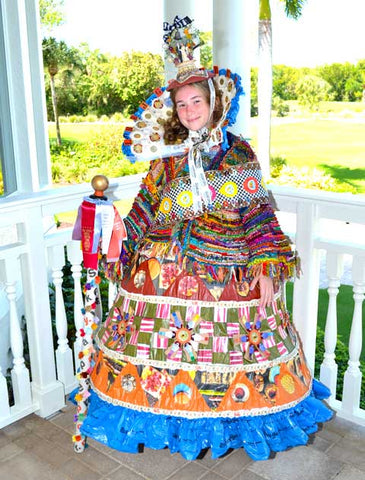 Downton Shabby, Design Team: Penny Weinstein, Lois Dwartz, Model: Hayden Lambek
Downton Shabby, Design Team: Penny Weinstein, Lois Dwartz, Model: Hayden Lambek
Leave a comment